Last week I was fortunate enough to enter a contest run by the inimitable, unconscionably cool @saywha. For reasons I'll never know, I wound up being the only person to enter said contest, and thus won by default.
The prize was comics from @cryplectibles vault, and I picked three issues I needed to fill holes in my collection. One of those three, however, wasn't just a hole-filler--it was selected for curiosity value as well. That would be part one of a three-part bad girl book from 1994 by Everette Hartsoe entitled Razor: The Suffering.
Specifically, this one right here:
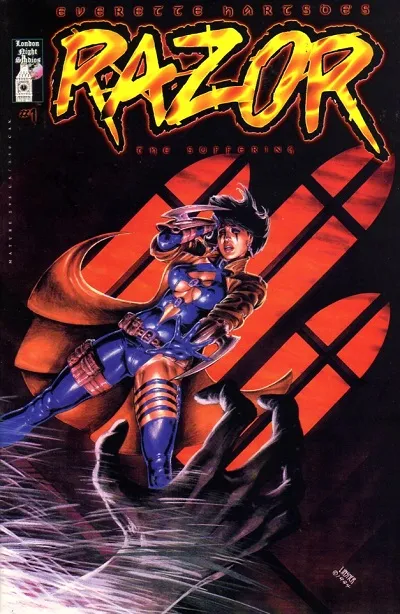
Image scanned just now by yours truly.
At some point I'll get around to doing a post devoted to bad girl books, but today I'm just looking at this particular issue. I'm an unabashed fan of these 90's artifacts, and Razor always appealed to the teenager in me. Hartsoe's idea for her was basically "a female Batman dressed in goth attire with Wolverine's morals (and also wrist knives)", so of course she was awesome, and...look, in my defense, did I mention it was the 90's?
Now, I wasn't interested in this book for the story. I'd read it years ago, and already had it in my collection as Razor: The Suffering (Director's Cut), printed in 1995:
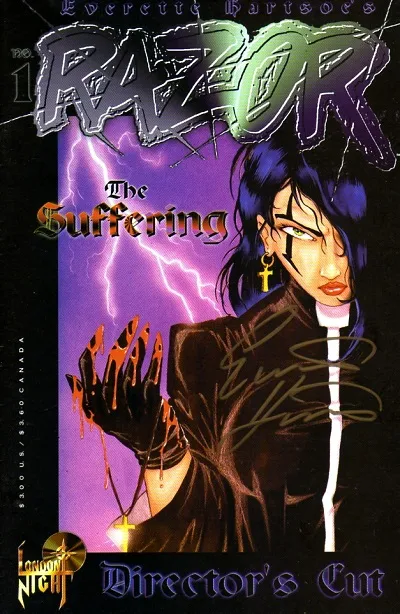
Source: Me.
Whoops, that's the one signed by Hartsoe. (Did I mention it was the 90's...?) Hang on, I'll get the right one for you.
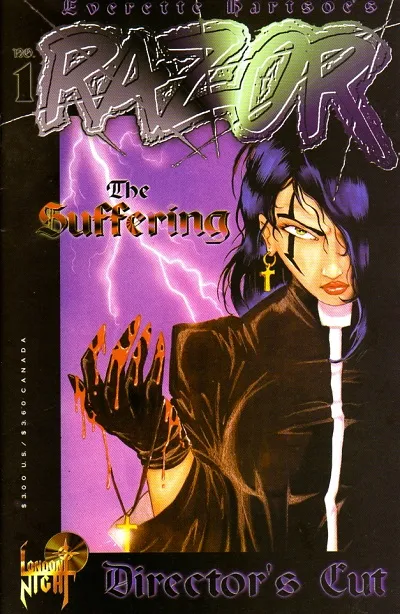
Source: Also Me.
Sorry for the confusion. Anyway, having only read the Director's Cut, I was curious what, besides the cover artwork obviously, was different between the two, if there was any reason to own both, or if one could get by with just the Director's Cut. Having teased that I might do a post about it in my contest entry, I'm now indulging that opportunity. Let's dive right in, shall we?
The differences begin with the first page. The original edition features a title page with a plain black background and very basic indicia information. The Director's Cut features a decorative marble background, with more robust indicia, and an added "Special Thanks" credit to Jude Millien, Slick, and Joseph M. Linsner. In the standard edition, Linsner is credited as "Cover/Inspiration by".
Page two in both books depicts a dedication to Roberta Lorene Hartsoe, Everette's younger sister, below a 1/3 page bust drawing of Razor in a cemetery. It's printed in a normal font in the standard edition, but given a Gothic font in the Director's Cut.
Page three in the standard book opens the story with a quote attributed to Hartsoe. In the Director's Cut, this has been moved to the back of the book and serves to close the story instead.
We open with Razor walking through a cemetery, stopping at her father's gravestone to say she misses him. We see the first addition to the Director's Cut with this full-page artwork:

Source: Still me, but (c) Everette Hartsoe
She kneels before the stone and bids her father goodbye, only for a voice to intone her name ("NICOLE!"). She steps back as a zombie erupts from the earth, demanding to know why she let him die and didn't help him. Not exactly a fair question, since she was just a child when her dad was killed, but nobody said the undead play fair.
The Director's Cut's second addition is here, with a two-page spread of Nicole/Razor reacting to the corpse grabbing at her with horror and revulsion.
We cut to Nicole sitting up in bed, wincing at the nightmare, then getting up to knock the shit out of her punching bag for a bit.
Next scene shows a group of degenerate gangsters who have lost their cocaine shipment and are determined to "pop a cap in that punk's ass tonight". It's unclear whether Razor was responsible for their lost shipment, or if she's just out to clean their clocks, but either way, she interrupts their discussion by killing a guard and making her presence known. The leader orders his two remaining underlings to "Smoke that crazy bitch!"
Razor responds by firing a knife into his forehead, killing him, and bringing us to the fourth and final addition to the Director's Cut's artwork: a full-page panel of Razor, standing victorious over his body, followed by an overleaf page showing the reactions of the underlings, frozen like deer in headlights.
The book continues with Razor pulling the time-honored trick of identifying the gun carried by one of the thugs, counting the shots as she dodges, then gutting him when the hammer clicks:
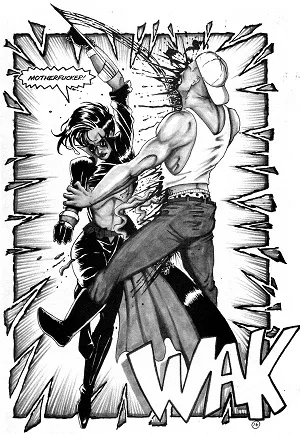
Source: Me me me, but (c) Hartsoe
Yeah, there's no getting up after that one.
Seeing what happened to his buddy, the other thug performs a time-honored trick of his own: that of getting the hell out of there. Razor goes to give chase, but pain in her spine, her head, and her arm brings her to her knees. The punk lives to see another day, which isn't normal when Razor shows up. With any luck, he used the opportunity to turn over a new leaf and now runs a recycling center in Queen City, or volunteers in the local library literacy program.
Later, back at her apartment, Nicole listens to a news report detailing the dead bodies discovered in the warehouse and berates herself for letting the last one get away. Refusing to accept that previous injuries need time to recover, she instead heads to the medicine cabinet in her bathroom, ties off her arm, and ups the dosage of the morphine to which she's addicted. It kills the physical aches, of course, but the book closes with a single panel of her in bed, arms wrapped around her knees, face pressed into her hands.
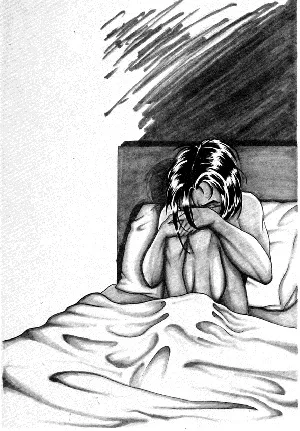
Source: Yup, still @modernzorker, but (c) Hartsoe
The mental pain never dulls.
As mentioned earlier, Hartsoe's quote from the start of the standard book makes its appearance now in the Director's Cut. It's much better served here; no doubt Hartsoe made the right decision to move it.
That could have been the end of the story, but of course it's not. The standard edition now demonstrates why it's worth owning with five full-page pin-ups of Razor in various poses and states from Hartsoe's sketchbook. These are missing from the Director's Cut for some reason (likely to keep costs down, since more pages = more printing costs), and for this reason alone it's worth owning them both.
The standard edition concludes with a full-page ad for the Razor fan club, a full-page ad explaining how to order from a variety of studios if your local comic shop is "afraid of 'outlaw' independent comics", a full-page solicitation for back issues and original Razor artwork for sale from London Night Studios, and a full-page ad for Joseph Michael Linsner's "Drama" from Sirius, coming June of 1994. The inside of the back cover features a gorgeous black-and-white rendition of the color cover for Razor: The Suffering #2. The back of the back cover is full black, no artwork or text.
The Director's Cut, by contrast, has no pin-up gallery, and all the ads are changed. Gone are the Razor fan club, 'outlaw' indie books, LN solicitation page, "Drama" ad, and cover artwork. In their place are solicitation pages for Comic Cavalcade, Raw Comics, Morning Star comics, and an ad for Mike Wolfer's forthcoming Widow: Metal Gypsies series from London Nights. Oddly, this same ad is repeated again right beside the first on the inside back cover. The back of the book's back cover features a full-color artwork ad for Razor: Burn #4 and Stryke #1, both coming June of 1995.
Final Verdict:
Generally speaking, the books are the same. Both feature 32 standard paper pages bound and stapled between heavier covers, though the standard version is printed on cardstock, while the Director's Cut is a low-weight gloss. The standard edition carries a cover price of $2.95 US, while the Director's Cut is a whole five cents more at $3.00. Canadians, as always, pay more for the privilege of being America's Hat, having to fork over $3.50 for their original edition, or $3.60 for the Director's Cut. Sure, they've got their national healthcare, but they pay through the nose for their comic books, so I'd call it a fair trade.
The story proper is identical between the two books, save the five extra pages of artwork the Director's Cut received, though if it matters to you, the blacks are deeper and richer in the standard edition--for some reason, the Director's Cut is lighter. Those five extra pages of artwork, however, come at the cost of the sketchbook pages from the standard book. If you're a fan of Razor or Hartsoe, then of course you'll want both.
What if I could only pick one? That's a frickin' hard question. They each have their good points. I like the sketchbook pages from the original, but the extra art in the DC actually adds to the story itself, not just the page count. The blacks are richer in the standard version, and I like the heft and feel of the standard's cardstock cover over the glossy paper DC cover, but the DC's cover artwork is better than the cover of the regular edition.
In the end, it comes down to which presents the story better, and in that regard, despite all the normal book has going for it, I have to give the win to the Director's Cut. Moving Hartsoe's quote to the conclusion of the story alone gives it an entirely different tone, and the Gothic-style lettering of the dedication and quote are a much better choice than the otherwise ordinary font used in the standard book.
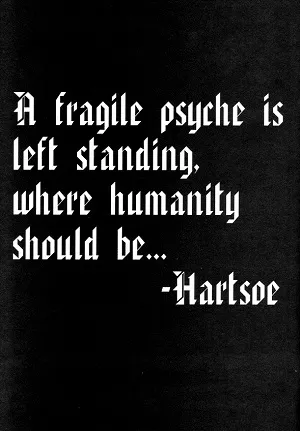
In the end, that's not just Razor. That's all of us in the face of loss. We're all suffering from the fatal sexually-transmitted disease called 'Life', and it's up to us how we live with the years we have. Hartsoe created Razor in part to work through the death of his younger sister in a manner that wouldn't land him in prison, and every time I read this silly, simple, and simplistic story, I can't help but get caught up in the tragedy.
Yes, this was the 90's...but the 90's are twenty-some years gone by now. The Suffering reminds us that we're all one awful event away from that fragile psyche. Razor will be Hartsoe's legacy after he's gone--ask yourself what yours will be when the crow comes to collect you.
Thanks once again to @saywha for his contest, @cryplectibles for his merchandise, my long-suffering wife for putting up with my varied hobbies, and of course, you for reading, upvoting, resteeming, and/or sharing this post. I couldn't have done it without any of you. :)